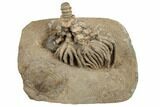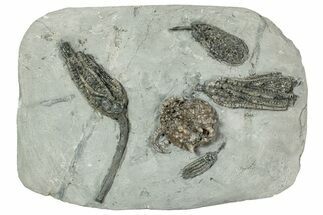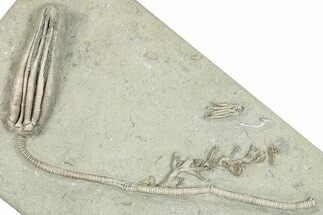This Specimen has been sold.
Fossil Crinoid With Starfish & Brachiopod - Crawfordsville, Indiana
This is a really fascinating piece from the Edwardsville Formation near Crawfordsville, Indiana. There is a very detailed, 3D crinoid (Actinocrinites gibsoni) with a small starfish (Onychaster flexilis) attached to it. It has been mounted to a piece of limestone that has a nice Echinoconchus alternatus brachiopod fossil on it. It is a composite meaning the crinoid + starfish were not found on the same piece of rock but they did come from the same layer at the same locality.
Crinoids from the Ramp Creek Limestone were likely buried in sediment from nearby deltas during storms. The resulting siltstone deposits are soft enough that fossils can be extracted in exquisite, three-dimensional relief.
Crinoids, sometimes commonly referred to as sea lilies, are animals, not plants. They are echinoderms related to starfish, sea urchins, and brittle stars. Many crinoid traits are like other members of their phylum. Such traits include tube feet, radial symmetry, a water vascular system, and appendages in multiples of five (pentameral). They first appeared in the Ordovician (488 million years ago) and some species are still alive today.
Crinoids, sometimes commonly referred to as sea lilies, are animals, not plants. They are echinoderms related to starfish, sea urchins, and brittle stars. Many crinoid traits are like other members of their phylum. Such traits include tube feet, radial symmetry, a water vascular system, and appendages in multiples of five (pentameral). They first appeared in the Ordovician (488 million years ago) and some species are still alive today.
SPECIES
Actinocrinites gibsoni, Onychaster flexilis & Echinoconchus alternatus
LOCATION
Crawfordsville, Indiana
FORMATION
Edwardsville Formation
SIZE
Starfish .8" wide on 2.9x2.6" limestone
CATEGORY
SUB CATEGORY
ITEM
#188702
We guarantee the authenticity of all of our specimens.
 Reviews
Reviews















